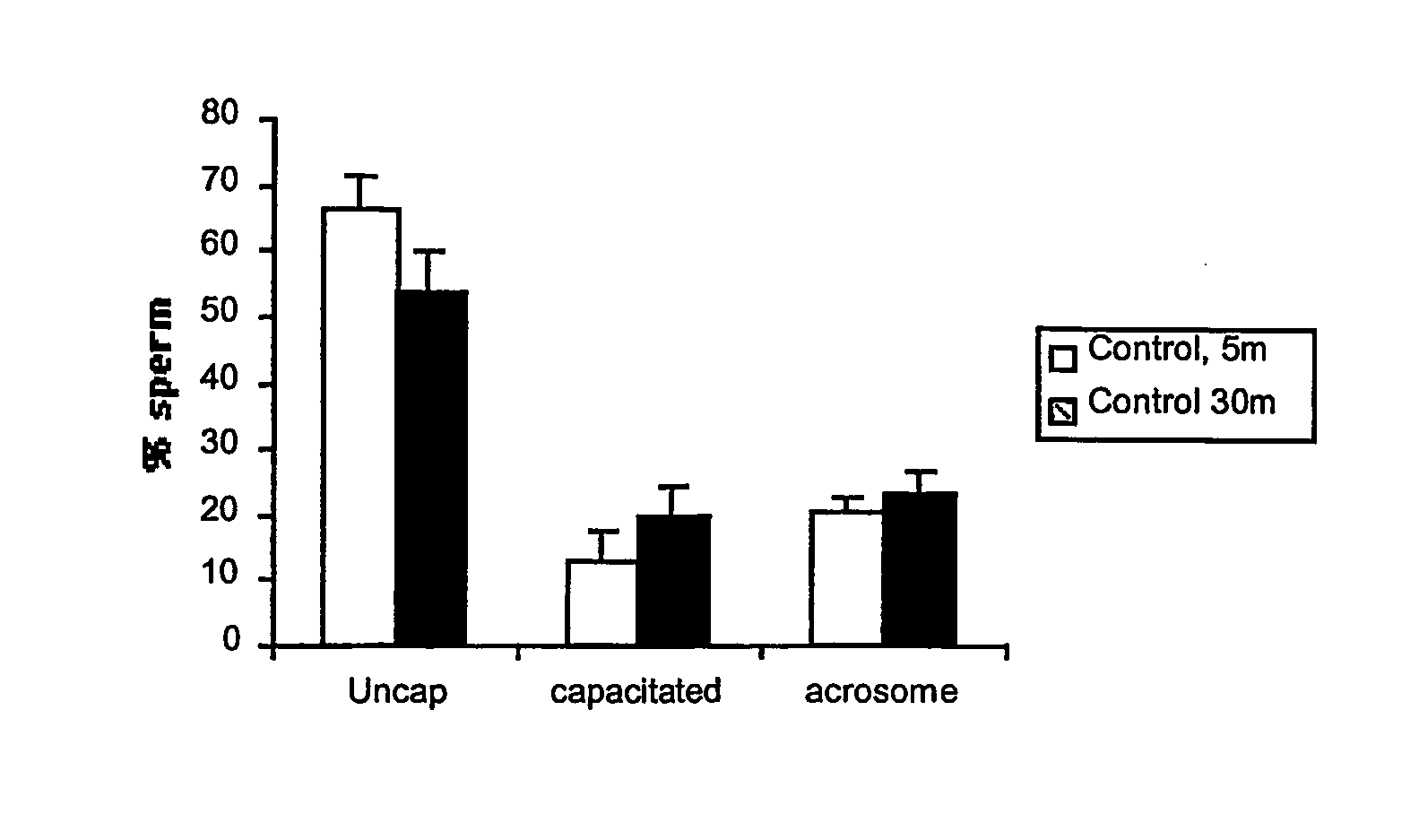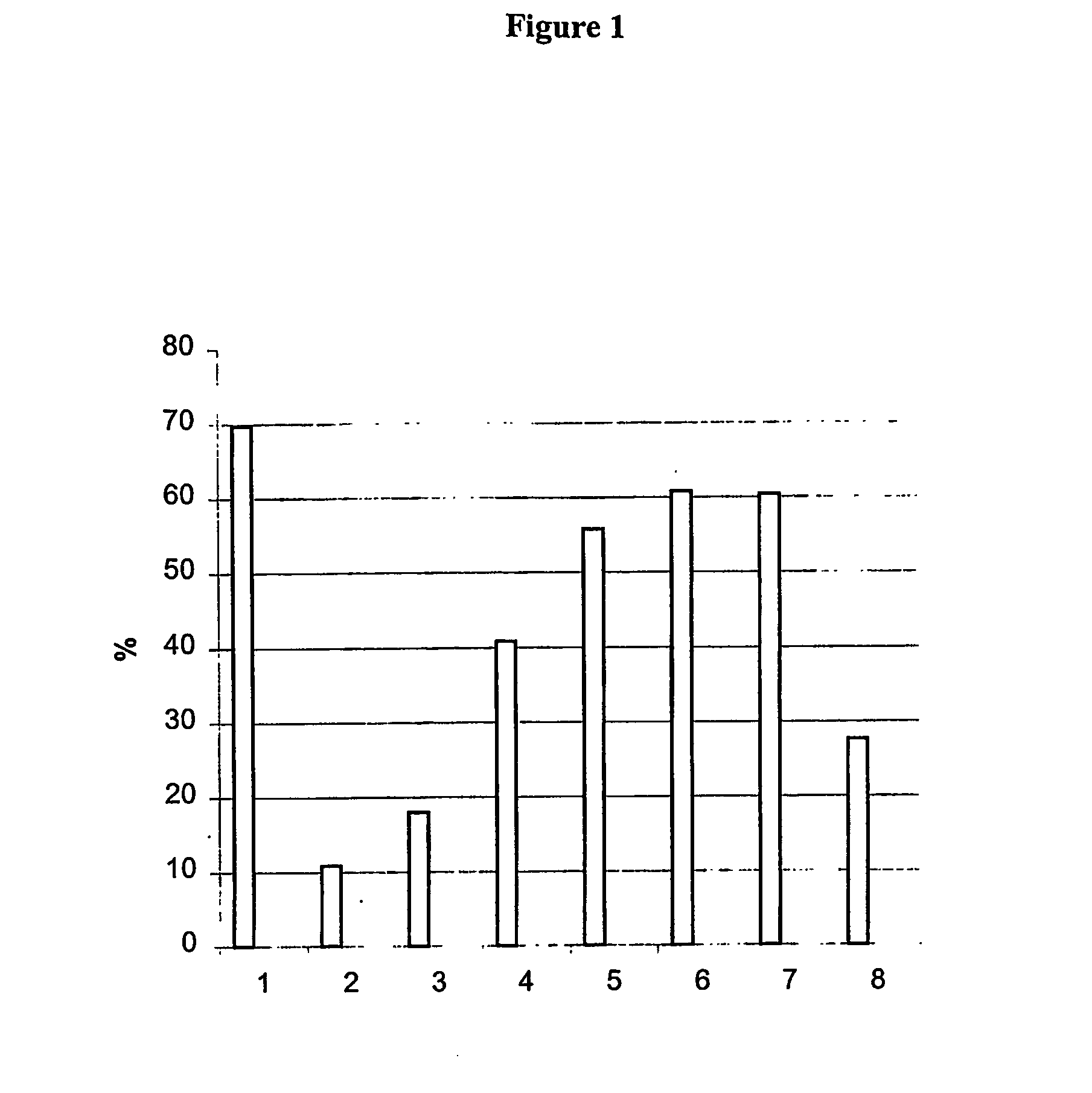Regulation of Sperm Function
a technology of sperm function and sperm, which is applied in the direction of peptides, drug compositions, peptides/protein ingredients, etc., can solve problems such as impaired fertility, and achieve the effect of enhancing motility and reducing motility
- Summary
- Abstract
- Description
- Claims
- Application Information
AI Technical Summary
Benefits of technology
Problems solved by technology
Method used
Image
Examples
example 1
[0055] Samples of thawed sperm were incubated with additives as follows:
[0056] 1. Sperm were incubated with fibronectin (2 μg / l) for 10 minutes.
[0057] 2. Sperm were incubated with fibronectin (2 μg / l) plus RGDS (5×10−6 moles / L) for 10 minutes.
[0058] 3. Angiotensin II (10−9 moles / L) was added to the fibronectin plus RGDS sample and incubated for further periods of 10, 20, 30 and 40 minutes.
[0059] All incubations were carried out at 37° C., using water bath and heated stage. Semen samples (10 μl) were applied to preheated (37° C.) slides and placed on the microscope heated stage and examined. The number of motile sperm were counted in the control sample at zero time, and in the treated samples after the incubation times indicated.
[0060] The results are shown in FIG. 1 in which the columns show motility values for
[0061] 1. control 0 time;
[0062] 2. fibronectin 10 min;
[0063] 3. fibronectin+RGD 10 min;
[0064] 4. fibronectin+RGD+Angiotensin II 10 min;
[0065] 5. fibronectin+RGD+Angi...
example 2
[0074] Samples of thawed sperm were incubated with additives as follows:
[0075] 1. Sperm were incubated with fibronectin (2 μg / l) for 10 min.
[0076] 2. Angiotensin II (10−9 moles / L) was added to the fibronectin sample and incubated for further periods of 10, 20, and 30 minutes.
[0077] The results are shown in FIG. 2 in which the columns show motility values for
[0078] 1) control 0 min;
[0079] 2) fibronectin 10 min;
[0080] 3) fibronectin+Angiotensin II 10 min;
[0081] 4) fibronectin+Angiotensin II 20 min;
[0082] 5) fibronectin+Angiotensin II 30 min;
[0083] 6) control after 30 min;
from which it can be seen that:
[0084] a) Control sample showed 79% motility at the time zero
[0085] b) The effects of fibronectin concentration on the sperm showed a highly significant change in total sperm motility. After incubation of 5-10 minutes there was only 8% sperm motility.
[0086] b) By addition of Angiotensin II to the sample, there was a significant change in sperm motility. At the time 10, 20, ...
example 3
[0088] Samples of thawed sperm were incubated with additives as follows:
[0089] 1. Sperm were incubated with RGDS (5×106 moles / L) for 5 min.
[0090] 2. Fibronectin (2 μg / l) was added to the RGDS sample and incubated for a further 5 min.
[0091] 3. Angiotensin II (10−9 moles / L) was added to the fibronectin+RGDS sample and incubated for further periods of 10, 20, and 30 minutes.
[0092] The results are shown in FIG. 3 in which the columns show motility values for
[0093] 1) control 0 min;
[0094] 2) pre-incubation with RGD 5 min;
[0095] 3) RGD+fibronectin 5 min;
[0096] 4) fibronectin+RGD+Angiotensin II 10 min;
[0097] 5) fibronectin+RGD+Angiotensin II 20 min;
[0098] 6) fibronectin+RGD+Angiotensin II 30 min;
[0099] 7) control 30 min;
from which it can be seen that:
[0100] a) Control sample showed 62% motility at the time zero.
[0101] b) Pre-incubation of RGDS with sperm showed 19% decrease in sperm motility.
[0102] c) The effects of fibronectin concentration on the pre-incubated RGDS with s...
PUM
| Property | Measurement | Unit |
|---|---|---|
| Time | aaaaa | aaaaa |
Abstract
Description
Claims
Application Information
 Login to View More
Login to View More - R&D
- Intellectual Property
- Life Sciences
- Materials
- Tech Scout
- Unparalleled Data Quality
- Higher Quality Content
- 60% Fewer Hallucinations
Browse by: Latest US Patents, China's latest patents, Technical Efficacy Thesaurus, Application Domain, Technology Topic, Popular Technical Reports.
© 2025 PatSnap. All rights reserved.Legal|Privacy policy|Modern Slavery Act Transparency Statement|Sitemap|About US| Contact US: help@patsnap.com



